Temples of Delhi
An Exploration of India's Religious Heritage
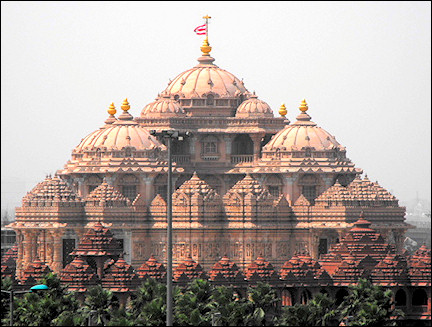
|
The cultural riches of India are reflected in the variety of temples that are visited in this story of a young man in search of his roots. Scattered all over Delhi, the itinerary offers the opportunity to also explore the neighborhoods around the temples.
Travelogue & photos:
Gaurav Bhan
Swaminarayan Akshardhaam
A Tribute to the Glory of Elephants in Indian Culture
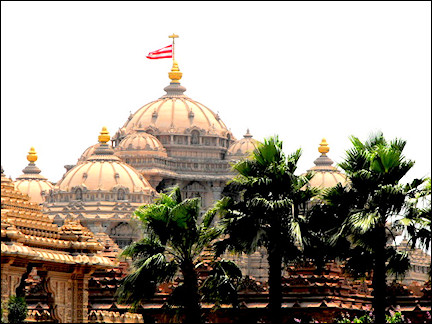
|
Although I passed the Akshardhaam Temple a zillion times in my car, giving it a fleeting glance, this is the first time I am here as someone genuinely interested. It is early morning and Swaminarayan Akshardhaam temple, which is built on the banks of thr Yamuna River is bathed in gold by the sun.
The temple showcases Indian art, wisdom, heritage and values and is a torchbearer of Indian culture. Akshardhaam, built over a period of 5 years as a tribute to Bhagwan (Lord) Swaminarayan, radiates peace, joy and divinity.
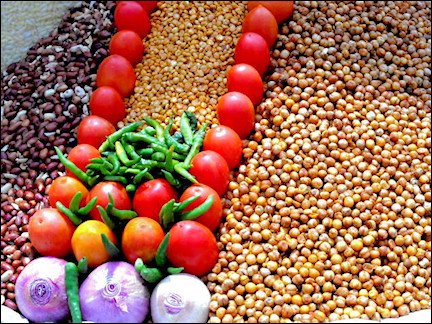
|
It is a ten minute walk from the subway station towards the temple entrance. En route, I find numerous hawkers selling green coconuts, jaljeera (an Indian green drink made of mint leaves), bhel puri (a spicy Indian snack originating from the state of Maharashtra containing green chillies, onion, tomato, ground nuts garnished with Indian spices, coriander and lemon juice).
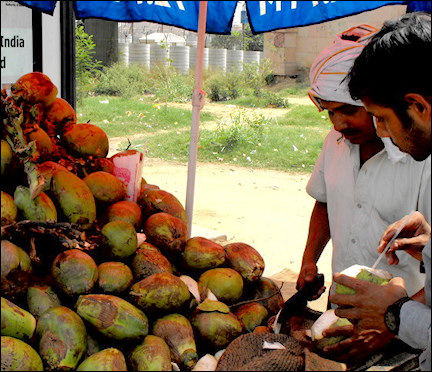
|
A sip of coconut water in the scorching Indian summer can keep you going for hours, feeling refreshed and bouncy. The jaljeera seller is ecstatic to have his photograph clicked. He offers me a glass full but I politely decline, fearing an unwelcome infection.
I go through multiple layers of high profile security at the temple entrance. Along with photo shooting devices, leather goods like bags, belts and wallets are also not allowed inside the temple. I see tourists from various regions of India and across the world.
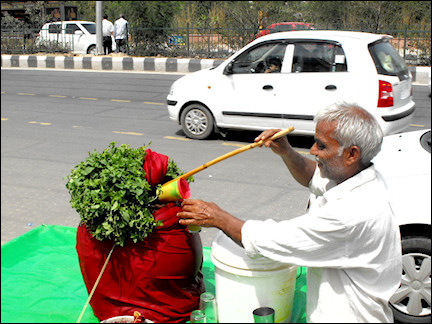
|
Visitors are welcomed by an arena of ten gates, intricately carved out of red stone. The Ten Gates reflect the Vedic sentiment of inviting goodness from everywhere to all visitors. This is followed by Bhakti Dwar (Gate of Devotion), which offers devotion to God.
The Bhakti Dwar is decorated with 208 sculpted images of God and his manifestations and human devotees Following this is the Mayur Dwar (Peacock Gate), which is adorned with 869 sculpted figures of the peacock, the national bird of India.
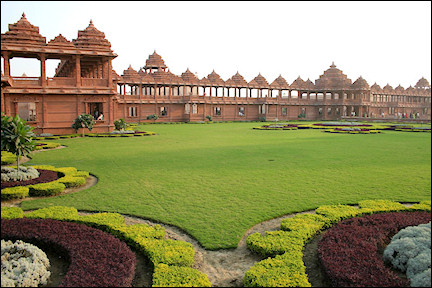
|
Right after the Mayur Dwar are the holy footprints of Bhagwan Swaminarayan. They are carved out of white marble and bear the sixteen sacred signs of God. Water is continuously showered on them from four conch shells. I stop to take some notes but to my annoyance a guard comes running to me and stops me.
With a guilty smile on my face I put my notebook back in my pocket. Within moments I am again carried away into a space of awe as I move ahead towards the main temple complex.
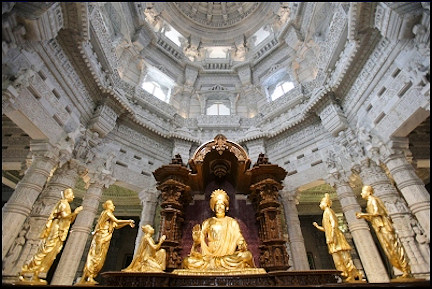
|
The grand Akshardhaam monument is carved out of pink stone and white marble. It was built without the use of steel and contains 234 intricately carved pillars, nine magnificent domes and over 20,000 carved figures. Seated at the centre of this monument is the 11 ft. high gold-plated murti (statue) of Bhagwan Swaminarayan.
The staircase to this murti is made of slabs of precious stone. There is a lot of pushing and pulling as people behind me crane their necks to get a glimpse of what I am seeing, but I stand my ground hypnotized for a long time determined not to let others steal my moment of joy.
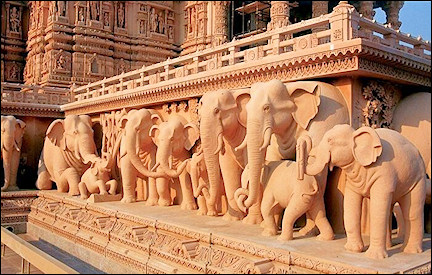
|
The whole monument rests on 148 life-size elephants carved out of pink stone and dozens of other sculptures of people, animals and birds. I read the descriptions in front of each of the carved elephants and find that they are a tribute to the glory of elephants in Indian culture.
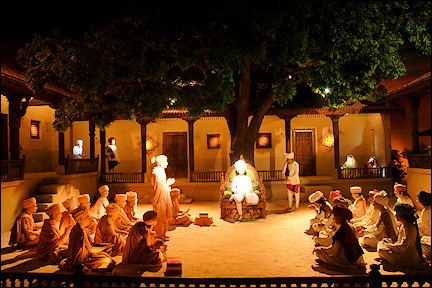
|
It is lunch time and I walk into the temple's own food complex. The food here is superior in quality and authenticity to that served in other restaurants in Delhi. The space is filled with the aroma of dishes being prepared in ghee (clarified butter) which was used in Indian cooking before cooking oil came into existence.
The extensive collection of Indian desserts makes me want to have all of them even though I am aware of my overfull tummy.
Sri Digamber Jain Lal Mandir
The marble floor is cool after the heat outside
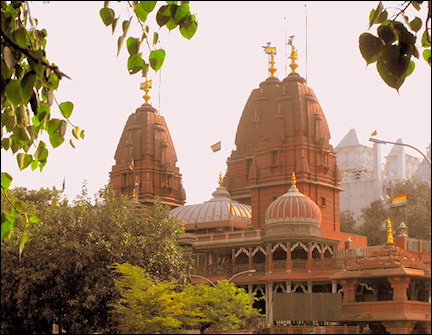
|
Next stop on my journey is the Sri Digamber Jain Lal Mandir (Sri Digamber Jain Red Temple). It is situated in the heart of Old Delhi, Chandni Chowk (Moonlit Square). Incidentally, Chandni Chowk, although one of the oldest parts of Delhi, is easily reached by subway.
Leaving the subway station, I make my way through the hustle and bustle of this place which always seems half finished. There is a lot of similarity between the narrow streets & shops of Chandni Chowk and those of the Grand Bazaar of Istanbul, Chandni Chowk being much bigger in size.
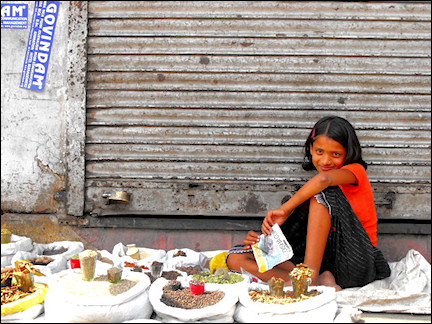
|
Sri Digamber Jain Lal Mandir is situated right in front of the Red Fort. This temple, made of red sandstone, was built during the Mughal reign of Shah Jahan in 1656. To my disappointment, photography is prohibited here as well. However, the smiling face of a girl selling local spices on the roadside lifts my spirits.
The girl's father is happy to have his daughter's photograph taken. Before I can snap a picture he asks me 'Are you a journalist?' I politely reply 'No, I am a traveller.' The girl then settles for some money to take her photograph. With a little chuckle I buy some cardamom pods in exchange for the money, take the photograph and move on.
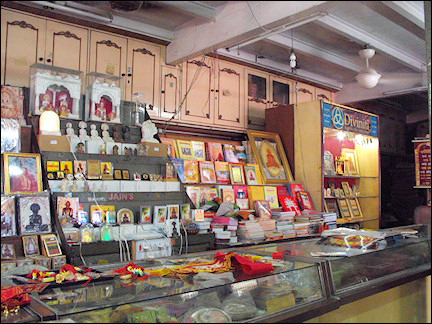
|
I arrive early and the temple is closed, as it's lunchtime for the priests. Finally, after waiting for an hour, the gates open. I remove my shoes and walk in. The marble floor is cool after the heat outside and it's bliss to walk barefoot on it. The complex is regularly washed to maintain its cleanliness.
Although Jainism originates in India, has numerous followers and I have read about it since childhood, it is my first visit to a Jain temple. The main shrine of this temple, dedicated to Lord Mahavira (the founder of Jainism) is truly magnificent. The walls and roof are decorated with fine enamel work which shines in the light of butter lamps and candles. Lack of maintenance has caused damage to the enamel work but attempts to collect donations and restore it are underway. Devotees regularly visit with offerings such as rice, grain, fruit and candles.
The complex also houses a library with Jain literature and a charity hospital for birds. The hospital is dedicated to Lord Mahavira's message of 'Live and let live'.
Gauri Shankar Mandir
People rub their noses on the steps of the shrine
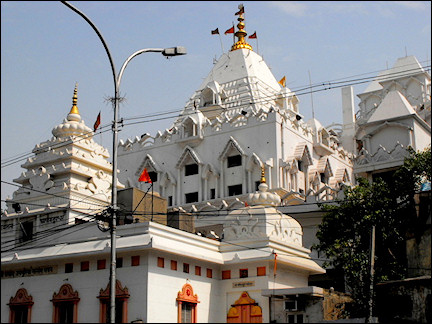
|
Gauri Shankar Mandir (Temple) is situated right next to the Digamber Jain Temple in Chandni Chowk. Made of white marble, this temple is dedicated to Lord Shiva (the destroyer or the dissolving force in life) and Parvati (complete incarnation of the original creator, preserver and destroyer of the whole universe). The sect of Hinduism dedicated to the worship of Lord Shiva is called Shaivism.
This 800 year old temple stands amidst the mixed fragrance of flowers in the nearby flower shops. One of the most important temples of Shaivism, it has an 800-year-old brown lingam (phallus stone) encased in a marble representation of a vagina. Surrounded by snakes made of silver, the lingam according to Hinduism represents a 'cosmic pillar, the center of universe, life itself'.
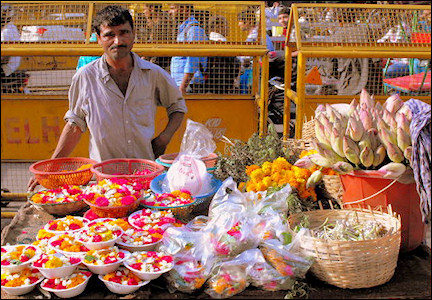
|
This temple may be smaller than the Swaminarayan Akshardham, but its age-old history and the sight of the faithfull make this place worth a visit. I just sit on the marble stairs and watch the faithful. A tradition that I find intriguing is folding one's hands, kneeling down and rubbing one's nose on the steps of the main shrine before entering it.
The faithful give offerings of bilva (wood apple), chandan (sandalwood paste), marigolds, red powder, rice and kelava, cotton threads. There are some vendors selling packages of these offerings, giving the surroundings a colourful look.
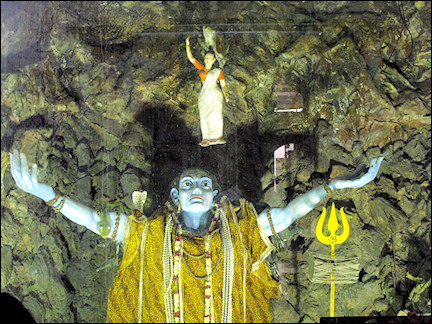
|
Inside the temple I am amazed to see an approximately 20 ft. tall statue of Lord Shiva with arms wide open as if calling on the energies of the universe. It is kept in a glass case. Outside the glass case on one of the walls is the trishula (Indian trident), a weapon of Lord Shiva. Along with the trishula there is a huge bronze idol of Nandi (the bull which serves as the gatekeeper of Shiva and Parvati).
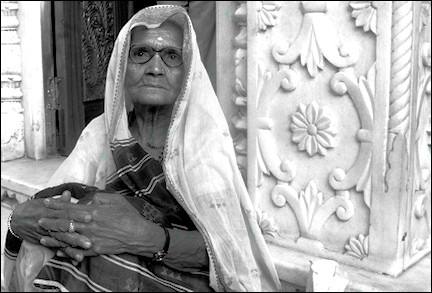
|
Sitting there, I observe people giving money and prasad (food considered to contain the deity's blessings) to an old lady who, in turn, gives them her blessings. She must have spent quite a lot of time here because almost everyone seems to know her. I approach her, give some money, and touch her feet to seek blessings.
To my surprise she squeals with happiness. She keeps her hand on my head to bless me. The warmth and love in her voice and actions fill my heart with joy.
Lotus Temple
The Bahaí House of Worship

|
It's August and monsoons have arrived in New Delhi. It is a welcome break after months of scorching summer heat. This morning it's pouring again.
My first stop is the Bahaí House of Worship, commonly known as Lotus Temple. This magnificent structure has the shape of a lotus with 27 petals of white plaster covered with white Greek marble.
Surrounding the temple are nine pools of deep blue water, as if the concrete flower is floating. The pools also play a significant role in the natural cooling system of the main prayer hall.
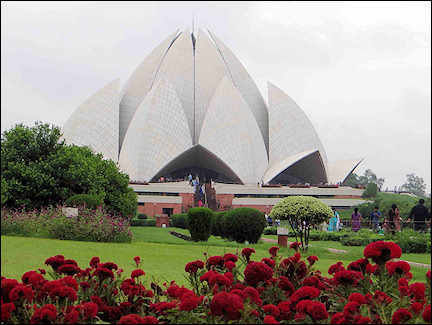
|
Lotus temple, although a place of worship for the Bahaí community, is flocked with people of all faiths as well as tourists all year round. The Lotus temple is one of the biggest structures of Bahaí worship in the world. It is spread across 26.6 acres of grasslands with trees and flowers.
The most convenient way to reach it is by subway. Cross the road and walk 200 m. from Nehru Place station. There is sufficient parking space for private vehicles and tourist buses. Entrance is free, the temple is closed on Mondays.
I walk through the main gate between rows of trees on both the sides of the walkway, alternating with small marble lamps that illuminate the space at night.
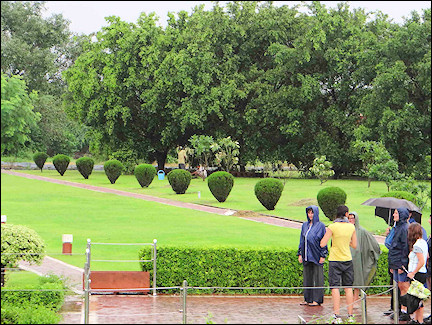
|
I am in no hurry and take my time to stroll around in the vast space and enjoy nature. The noise of honking vehicles and yelling hawkers outside fades. The magical silence of this paradise is taking over with occasional plops of raindrops falling on leaves and in puddles of water.
I walk through the grasslands towards the main building. Wearing shoes beyond a certain point is prohibited. I am happy to see that the tourists are well managed by the volunteers and there is no pushing. At the entrance of the prayer hall I am asked to stand in a queue and await a warm welcome by the volunteers followed by a two minutes introduction to The Lotus Temple and Bahaí faith.
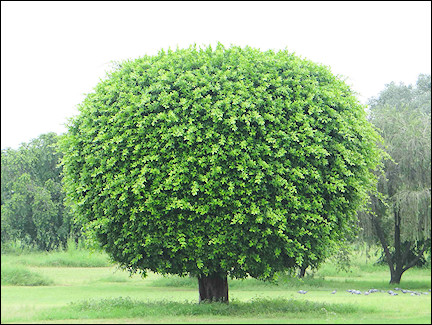
|
We are welcomed in Hindi as well as English. I move inside, where I experience silence like never before. Photography is prohibited inside because of the noise that a camera click makes. There are rows of wooden benches with marble surfaces to sit on and pray. 1300 people can sit inside this prayer hall. The floor is clean and a bliss to walk on.
I hear an occasional squeal of a child which is echoed multiple times before it slowly fades off. With the external sounds being cut off, I can visualize my thoughts and choose which ones I want to keep. I begin to experience the various sensations in my body, the vibration in my calf muscles and my heartbeat. Slowly the space takes away my fatigue. I feel my muscles rejuvenating. I sit there for a whole hour. By the time I come out, I feel vibrant, energetic and peaceful, a combination rarely experienced in today's lifestyle.

Outside the prayer hall Farida, a volunteer from Iran, tells me that Bahaí faith teaches equality of all religions. One of the prayers by Bahaú'llah, the founder of Bahaí faith, is: 'God grant that the light of unity may envelop the whole earth, and that the seal The Kingdom is God's may be stamped upon the brow of all its peoples.'
Farida further explains that Bahaí faith originated in Persia (present day Iran). After the persecution of Bahaí people by Iran's religious orthodoxy in the early 20th century, Bahaís migrated to various countries around the world. India has the largest population of approximately 2.9 million. Presently, Bahaí centres of worship exist in Israel, Western Samoa, Australia, Uganda, Panama, Germany and the USA.
It is time for me to move on to the next destination. I leave this place with another saying by Baha'u'llah in my mind:
'It is not for him to pride himself who loveth his own country, but rather for him who loveth the whole world. The earth is but one country, and mankind its citizens.'
Ahimsa Sthal (Place of Non-Violence)
A Peaceful place of beauty
Ahimsa Sthal was not on my itinerary initially but on my way to the Chhattarpur Temple I stopped at this small but interesting place. Ahimsa Sthal, which translates as A place of non-violence, is a small Jain shrine perched on the top of a rocky hill near Mehrauli. Being a Jain shrine it is dedicated to Lord Mahavira.
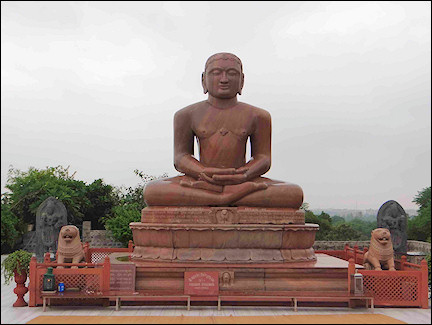
|
The best way to reach this place if you are not in your private vehicle is by subway. The nearest subway station is Qutub Minar. Ask for directions outside the station. Do not hire an auto-rickshaw as this is at walking distance. Other attractions like Qutub Minar are nearby and one can easily combine these two in a single visit. Ahimsa Sthal is open seven days a week.
I park my car outside and walk in. Entrance is free. Although this place is smaller than the Lotus temple it is equally well maintained. The gardens and walkways around it are very well kept. I climb a flight of stone stairs to reach the main terrace where a 14 feet statue of Lord Mahavira stands.
Lush green plants and trees grow from the crevices in barren rock in this place. Trees which probably germinated in the soil below these rocks have cracked the rocks apart. In Indian mythology it is believed that the aura, energy and purity of the space can make it green and fertile. If the aura is negative and disturbing it can convert a lush green land into a barren patch.
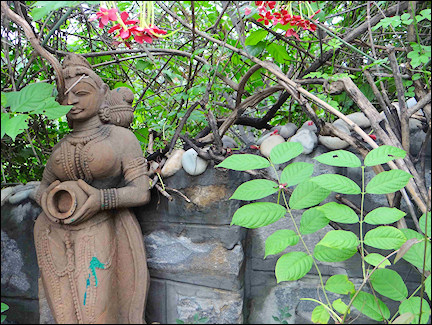
|
On the way down, there are numerous statues of apsaras (female spirit of the clouds and waters) scattered around. These small things make this place extremely peaceful, beautiful and a pleasure to visit not only once but regularly. I would like to stay here longer, if only there weren't other destinations on my list.
Chhattarpur Temple
The second largest temple complex in Northern India
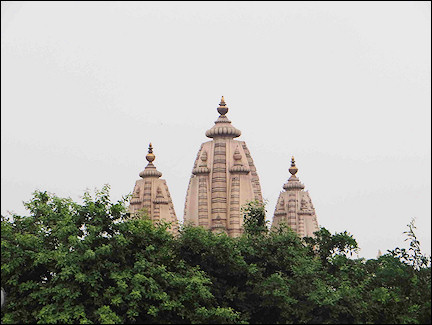
|
My next destination is the Chhattarpur Temple complex. Believe me, if the cars were replaced by horse-drawn carriages and people were more traditionally dressed, this place would look like an ancient kingdom. Even now it's a kingdom by itself: the complex comprises of twenty temples ranging from small to massive.
Spread across 60 acres of land, this is the second largest temple complex in Northern India after Swaminarayan Akshardhaam. The largest one in all of Asia is Angkor Wat in Cambodia.
It is in the vicinity of Qutub Minar and Ahimsa Sthal. The nearest subway station is Chhattarpur. It's just a short walk from there.
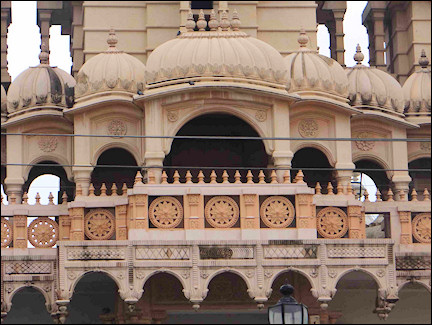
|
I park my car and take a picture of the Chhattarpur temple looming high above my head and the trees. The jaali (lattice) work in stone around the temple balconies, although comparatively simple compared to various other lattice works across India, is very beautiful. The temples' architecture is a mix of North and South Indian art.
I take a deep breath and start with the Shiv Gauri Nageshwar Temple. Right at the entrance is a huge trishul (trident) covered with bronze snakes and a damru (small two-headed drum). A trident, in Indian Hindu mythology, is considered the main weapon of Lord Shiva. Trishul means 'three spears' in Sanskrit.
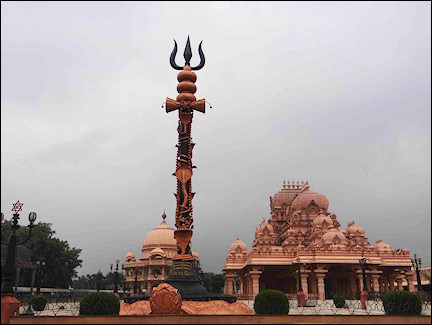
|
The three points of the trident represent numerous things. Most commonly the trinity of Creation, Maintenance and Destruction. In terms of time, they represent Past, Present and Future. The trident is mounted on a huge bronze tortoise. Behind the trident is a temple based on primarily South Indian architecture. This one is unfortunately locked.
Since I can't go in, I spend some time watching the fine artwork over the temple's walls. Right next to this temple is a huge shankh (conch shell).
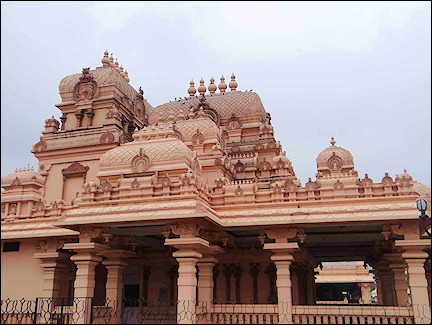
|
Try holding a conch shell against your ear. You will hear the sound of the ocean humming gently. In Hinduism it is considered the natural vibration of cosmic energy of the earth. That is why conch shells are often blown in Hindu religious ceremonies and in sacred rites to get rid of negative energy in the space.
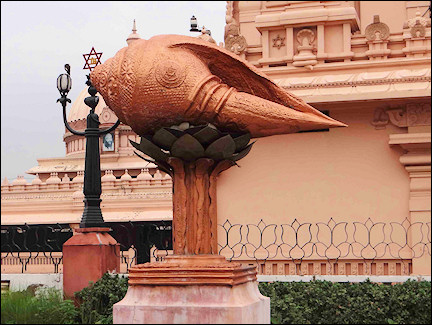
|
Up ahead is the Sri Shiv Gauri Nageshwar Temple. There are two huge elephants carved in black stone on each side of this temple's main entrance. I suppose they represent actual elephants which were used in ancient as well as medieval times to welcome and honour guests.
Even today, in lavish marriage ceremonies, elephants are used to welcome the guests and shower flowers on them with their trunks.
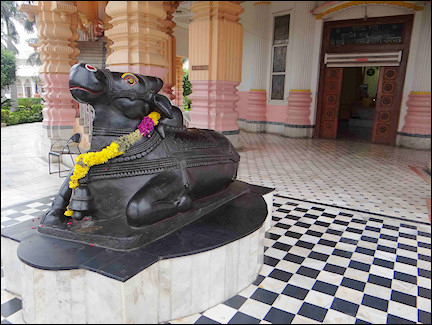
|
This whole complex was built by the Honourable Sri Sant Nagpalji. Sri Shiv Gauri Nageshwar Temple is the place where he attained Samadhi (the final liberation after dying) and became one with infinity in the year 1998.
Next to this temple is a towering red statue of Lord Hanuman. I am quite tall but not taller than even a finger of this statue. The open space is clean and the gentle breeze, blowing after a brief rain is soothing.
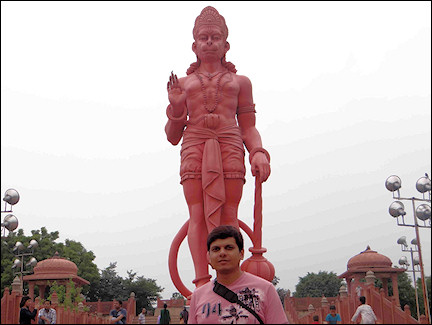
|
I cross the street to visit the Ram Temple. At the entrance is a tree which seems to be of great significance. There are countless lal chunni (pieces of red cloth like a shawl but smaller) tied to it. I ask the priest sitting nearby and he explains that people believe tying a chunni to this tree brings good luck to them and fulfills their wishes.
I do not have any wish that I desperately want fulfilled so I just watch this beautiful tree and move on.
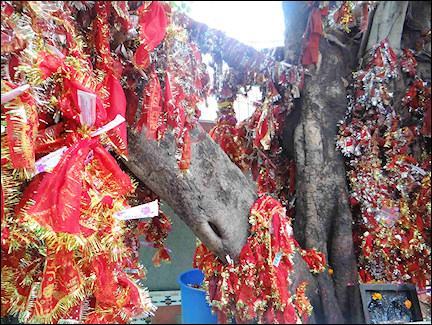
|
I hear loud music and move towards a huge hall filled with guests and some musicians singing devotional songs to Lord Krishna. Books on what they are singing are being distributed so the spectators can follow each and every word. The main singer sitting in the middle is smiling all the time as he is singing.
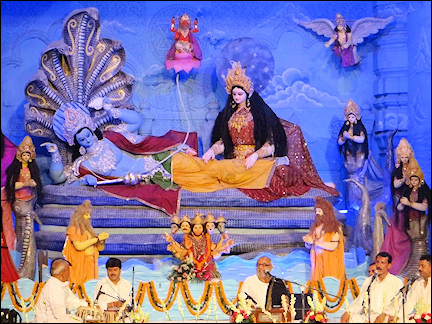
|
In the same temple complex are two rooms cased in glass, intended for the goddess Katyani. The first is a dining room with a table and chairs, some fruit, water and glasses. The second and most beautiful one is the shayan kaksha (bed room) with a beautifully carved bed and a carved silver dressing table with all the make-up that the Goddess would need.
Photography in this particular area and that of the idols is forbidden, so I decide to respect the sanctity even though no one is policing the visitors.
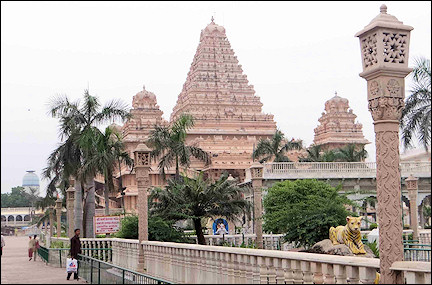
|
The last temple is the Laxmi Vinayak Temple. This one is a true depiction of the South Indian architecture. My legs should be tired by now from walking around but after walking around the entire day, I feel even more energetic.
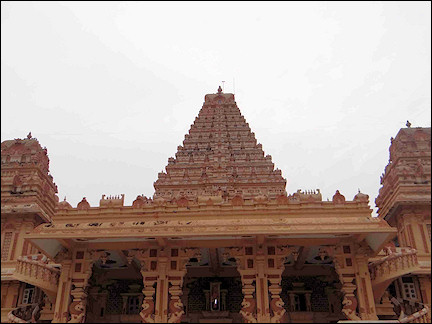
|
The lamp posts on the pathway to this temple are carved in similar patterns. I wonder what this place looks like at night. The pathway is lined with palm trees. There is a small museum as well in this temple dedicated to Sri Sant Nagpal Ji. It has a huge statue of Sri Sant Nagpal Ji at the entrance.
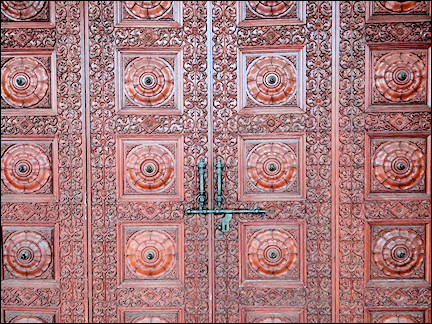
|
All the things he used, from his clothes, his bed, the medical equipment he used to treat people to even his jataayen (long hair tied together and typical for the priests and ascetics in India) are displayed.
The temple has three wooden gates. The middle one is open for visitors. The carvings on these huge doors are intricate.
Uttara Swami Malai Temple
The Priests Are Reciting Tamil Prayers
It's dusk and the light drizzle has started again. One more temple on which I have my eye since months is the Uttara Swami Malai Temple in R.K. Puram. This temple is dedicated to Lord Swaminatha (more commonly known as Lord Murugan) and mostly revered by Hindus in Delhi from the states of Andhra Pradesh, Tamil Nadu, Karnataka and Kerala.
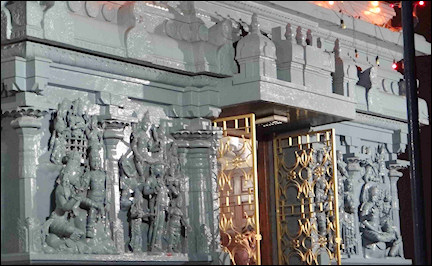
|
There are no subway stations near this temple, so take a bus. It is closed to visitors during afternoon hours from 12 to 5 pm. A sign outside the temple is written in Tamil, proclaiming Lord Swaminatha's motto Yaamirukka Bayamain which translates to 'Why fear when I am there?'
To reach the main temple, I have to walk and climb stairs as it is perched on top of a hill. Men and women speaking Tamil can be heard all around. Tamil prayers are being recited by the priests. There are men dressed in white veshtis and women in traditional sarees with fragrant white flowers entwined in their hair. The black statue of Goddess Meenakshi Devi is always dressed in bright kanjeevaram sarees.
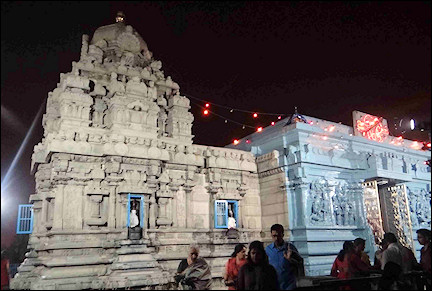
|
I am lucky to arrive here at 7 pm. People from a local south Indian community are gathered in the main shrine with baskets containing flowers and bananas. The priests are reciting synchronized prayers in Tamil. Curtains are dropped and we have to wait till the hymns are completed.
The moment the curtains are opened, people fold their hands and raise them high in the air to seek the Goddess' blessings.
This is a small temple but worth a visit in the evening. After the ceremony is over, I stroll around the small patio on top of the hill watching the lights of rows of traffic on the road below.